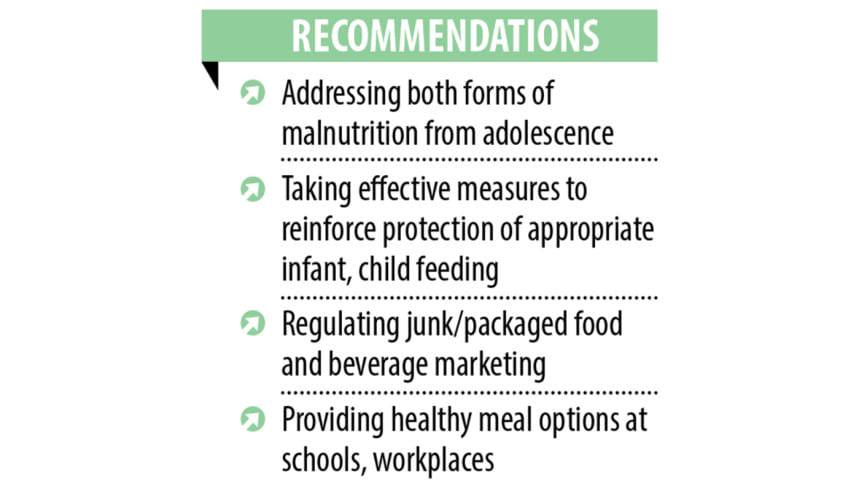1.7 crore women malnourished

Some 1.7 crore women, aged 15-49 years, are malnourished in the country, said the researchers at a discussion at the International Center For Diarrheal Disease and Research, Bangladesh (icddr,b) yesterday.
Based on the secondary analysis of Bangladesh Demographic and Health Survey (BDHS) datasets for the last decade, they said the nutritional status of Bangladeshi women has not been improving.
Meanwhile, obesity among women of this reproductive age group has appeared to be a new threat, which the country's maternal and child health programmes and policies have failed to address, said speakers.
"We see there is a gap in policy, however, we also have to keep in mind that, while the crossover from underweight to overweight among ever-married women of reproductive age started around 2012, the gap is more visible from BDHS 2017-18," said Dr Kanta Jamil, senior advisor for research, monitoring, evaluation and learning at USAID.
Between 2007 and 2017, in addition to improvements in many human development indexes, the proportion of malnutrition among Bangladeshi ever-married women aged 15-49 declined sharply from 30 percent to 12 percent, while the proportion of overweight women increased from 12 percent to 32 percent.
Shusmita Khan, a specialist in knowledge management and communications at Data for Impact (D4I), presented the keynote on the issue.
In the presentation, she mentioned that between 2007 and 2017, in addition to improvements in many human development indexes, the proportion of malnutrition among Bangladeshi ever-married women aged 15-49 declined sharply from 30 percent to 12 percent, while the proportion of overweight women increased from 12 percent to 32 percent.
Moreover, despite remarkable progress in reducing undernourishment among women, the share of well-nourished women remains unchanged, which was 58 percent in 2007 and 56 percent in 2017-18.
Currently, 17 million women of the aforementioned age group are malnourished in the country, while five million are underweight, and 12 million are overweight.
If this trend persists, linear projections indicate that about 46 percent of ever-married women of reproductive age will be overweight by 2030, said Shusmita.
Replying to queries from journalists, Saiqa Siraj, country director of Nutrition International, said, "Obesity is affecting our mothers and our children and creating an inter-generational challenge."
In Bangladesh, about 3.4 million births take place annually. Around 0.9 million of these births occur to overweight/obese women, and 0.5 million births occur to underweight women.
If the current trend in malnutrition continues, pregnancies/births among overweight women will increase.
Both forms of malnutrition pose a greater risk for maternal and child health. While, underweight mothers are at risk of having anaemia, antepartum/postpartum haemorrhage, and premature rupture of membranes, maternal obesity increases the risk of perinatal complications such as gestational diabetes, gestational hypertension, and caesarean deliveries.
Maternal obesity also has implications for breastfeeding, with decreased rates of initiation and reduced breastfeeding duration.
All these complications have potentially serious implications for infant survival, growth, and development, as well as inter-generational implications.
Experts at the event stressed addressing the challenge by tracking and addressing both forms of malnutrition from adolescence, taking effective universal interventions to reinforce promotion and protection of appropriate Infant and Young Child Feeding (IYCF), regulating junk/packaged foods and beverages marketing and providing healthy meal options at schools and workplaces.

 For all latest news, follow The Daily Star's Google News channel.
For all latest news, follow The Daily Star's Google News channel. 



Comments